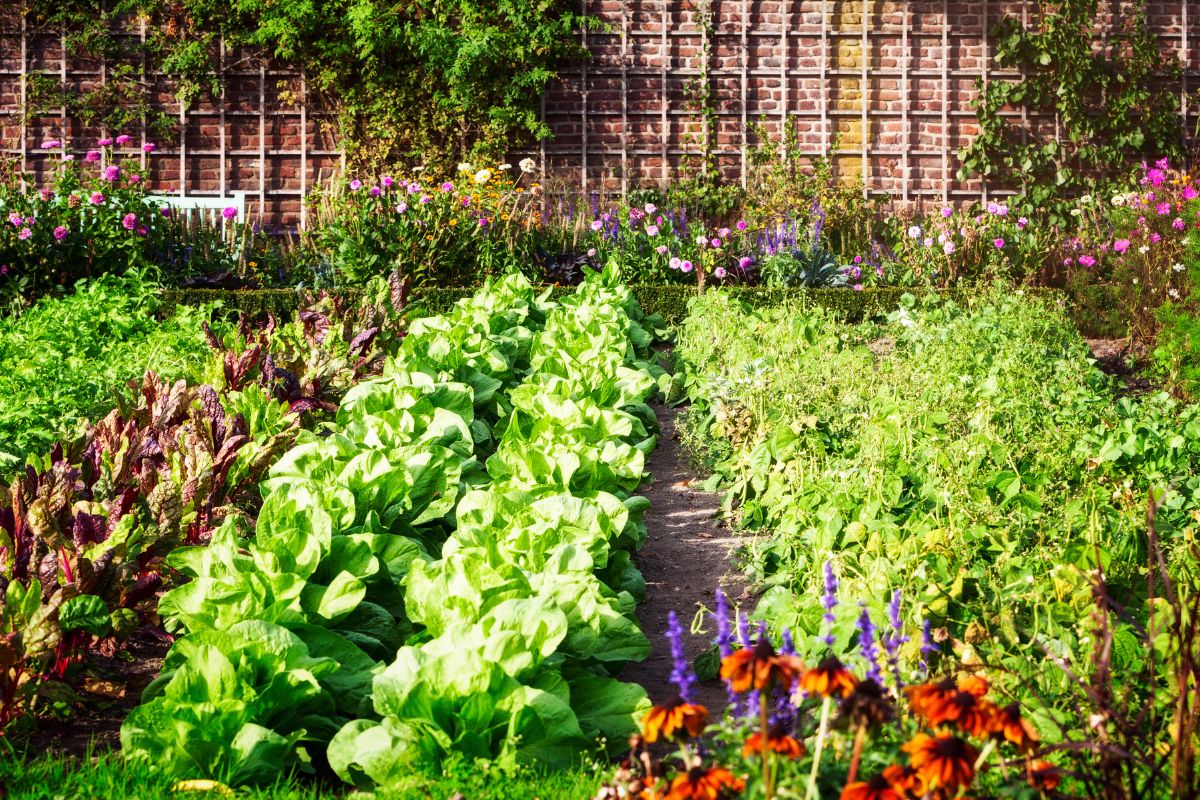
Pest-Free without Pesticides
For decades, growers have depended on pesticides as a defense against invasive pests and diseases ravaging their crops – but research has proven plenty of dangers associated with these chemicals.
Fortunately, there are safer alternative ways to protect crops, ones that can actually benefit the earth and its inhabitants. With a bit of planning and strategy, crops can flourish without risk.
Let’s dive into four alternative solutions that can help keep your gardens pest-free without the use of toxic pesticides.
Biological Control
This practice not only fights infestations, it is healthy for the environment! It involves attracting the natural enemies of pests and creating a habitat where they can thrive. These helpers are readily found in backyard gardens and commercial fields, and encouraging them to take up residence near produce plantings helps keep pests in check.
There are many facets of biological control. Three of them involve:
- Attracting beneficial insects;
- Cover Crops; and
- Hedgerows.
Attracting Beneficial Insects
Ladybugs, nematodes, lacewings, parasitic wasps, birds, bats, and more all feed on the predators that threaten our gardens. Attracting them is as easy as planting pollen-producing and nectar sources near your crop.
For instance, wild lilacs are a favorite among butterflies and bees, who are attracted to their fragrance. With good soil, these plants require little care once they’re established and will provide a home for beneficial insects who can help control natural threats to produce.
Other plant varieties that create a pollinator habitat and entice beneficial species include:
- Yarrow
- Purple coneflower
- Coral bells
- Lupine
- Sunflowers
- Foxglove
- Golden rod
- Sunflowers
- Beebalms
There are many more options to help you build a pollinator habitat. For best results, look for flowers, plants, and herbs that are native to your area.
Cover Crops
Cover crops are another method of biologically controlled pest management. Growing an alternative crop between primary harvests provides a haven for beneficial insects. Bonus: Cover crops improve soil health, control soil erosion, and can even bring in extra revenue! Peas, rye, and wheat make excellent cover crops to protect against plant threats while providing a potential extra revenue stream for farmers.
Hedgerows
Finally, hedgerows – rows of bushes or short trees – can be planted as a sort of fence or boundary, giving bats and birds a nesting and foraging habitat where they can thrive as they provide defense against pests.
Options that will do well as hedgerows include:
- Evergreen huckleberry
- Wax myrtle
- Redwood dogwood
- Blue or red elderberry
- Silk tassel
- Vine maple
Biological control is an effective and environmentally sound way to protect plants from the dangers of pests and diseases; however, it is not a fool-proof method. When an infestation is spotted, an all-natural plant care solution like GrowSafe should be applied directly to the affected area to kill pests on contact. GrowSafe is a proprietary solution of food-grade, organic ingredients that protect the entire plant when applied properly. It can be sprayed at any time during the growing cycle and won’t harm the plant or the environment (it’s safe for pets and people too!) from root to tip. GrowSafe gives farmers and gardeners peace of mind that their produce is safely and ethically farmed. However, the best way to prevent infestations from occurring is to preventatively apply GrowSafe to crops every 6 to 10 days.
Integrated Pest Management
Integrated pest management, or IPM, is a sustainable method of protecting vegetation that involves tools and strategies to control pests and viruses that feed on crops. Using science-backed methods, IPM prevents pest damage and reduces a resistance to other pest-management practices while minimizing environmental risks. IPM involves many practices.
Three of them include:
- Companion Planting;
- Intercropping; and
- Strip and Row Planting.
Companion Planting
Companion planting involves interspersing crops with pest-repelling plants like garlic, which has a strong odor that can help mask the scent that attracts insects. The goal is to deter natural pests (including destructive wildlife like deer and rabbits) but it has the added benefit of protecting light-sensitive crops and even crowding out weeds that might otherwise flourish in between plants.
Successful companion plants that flourish locally include:
- Cilantro
- Fennel
- Dill
- Celery
- Basil
- Marigolds
Intercropping
A related IPM practice is intercropping – planting two or more crops close enough to benefit at least one of them. For instance, planting a deep-rooted crop, like eggplant or cauliflower, with one with shallow roots like onions and shallots, improves land efficiency.
Beyond providing a better balance of light, water, and nutrients, intercropping is an effective method of natural pest control because it confuses insect pests and attracts beneficial insects like bumblebees and butterflies. Threats that thrive on one crop may be challenged to find a host due to the close proximity of different plants.
Intercropping also includes crop rotation, in which different crops are planted in the same field at different times of the year. Acreage with increased diversity not only keeps from depleting the soil of nutrients used for a single crop, but also makes it more difficult for insect pests to take hold and thrive.
A thoughtful strategy, like planting legumes followed by root vegetables, then fruit, followed by leafy greens, ensures soil can keep the appropriate balance of moisture and nutrients to benefit the harvests of each crop. Planting when particular pests are least active adds a layer of natural protection.
Strip and Row Planting
IPM also includes strip and row planting, in which two crops are either grown mixed in the same row or in adjacent rows.
How is it successful? The answer depends on the crops. Insects use visual cues to find a host on which to feed; by planting two different crops close together, an insect threat may not recognize its intended target. Varying the heights of the intercropped plants, like pairing corn with cabbage, will also throw pests off the scent of the produce they seek.
The practice of intercropping has an additional value: it avoids monocultures, an environment that insect pests crave for their nutrients. Growing only one crop at a time on a specific field not only results in soil degradation; it also provides a desirable home for diseases and/or pests that feed on the produce, enabling them to easily destroy an entire crop. As parasites reproduce – plants are doomed before they start. By interspersing your produce, each crop is more likely to flourish long term.
While IPM is an effective and sustainable approach to farming, it’s not fail-safe. Pests and diseases inevitably find their way to plants. However, integrating a preventative application of GrowSafe into your crop management routine will deter pests and diseases from settling in and making a home in your gardens.
Soil Management for Pesticide-Free Gardening
It’s a no-brainer that good plants grow in good soil. Healthy soil promotes the health of plant roots, supplies nutrients like carbon for better growth, and filters and distributes water for plants to flourish. It also plays an important role when it comes to protecting agriculture.
Much like a balanced diet for humans, nutrient-rich soil gives plants a healthy foundation from which to grow. Roots and stems can absorb vital nutrition to produce antioxidants that boost a plant's defense mechanisms, making it better able to tolerate damage from plant threats.
Well-controlled watering also helps soil fight off plant threats. Too much water can cause root rot, weakening the plant and providing an opening for damaging insect pests. Excess moisture is also a breeding ground for organisms.
But most plants can’t thrive in soil that is too dry. If a plant senses there is too little water, it will slow its absorption rate to retain moisture for as long as possible – which means it also limits the amount of beneficial minerals and fertilizer it absorbs.
When soil becomes hydrophobic it can be enticing for pests like mites, thrips and certain types of beetles that thrive in dry environments.
You can keep your soil fertile by implementing some of the IPM practices above, like crop rotation and companion planting. It’s also recommended to amend soil with compost to strengthen soil structure, retain moisture, and improve its health.
Physical Defense
Barriers like mulch, netting, and row covers provide a physical deterrent to some pests, blocking their access to tender leaves.
Mulch
A good organic mulch/compost blend can help prevent disaster in a few ways. The small bits of bark hold in beneficial moisture, ensuring crops have the water they need to stay healthy and thwart pests who feed on withering plant material. And if the soil has somehow become a breeding ground for pests, mulch can reduce the amount of potentially infested soil from splashing up against a plant’s stem and leaves. A final benefit? The organic matter within mulch provides beneficial microbes to support the soil and help keep vegetation strong and healthy.
Netting
Netting also offers an extra layer of protection by blocking potential threats. Whether applied over young seedlings or more mature crops, a tightly woven net is an effective way to protect produce, as long as all parts of the plant are covered and the net is securely fastened to the ground. This method works best with smaller areas of crops.
Row Covers
Row covers work the same way as netting, blocking exterior pests before they can reach the vegetation, but are a bit more versatile. Made of a lightweight fabric much like gauze, row covers vary in thickness, lengths and widths, and can be cut to size. These provide sun and weather protection which can increase the growing season while creating a barrier against insects, just be sure to remove them when pollinating plants begin to flower.
When using row covers, it’s important to visibly inspect the plants regularly to ensure no disease or infestation has taken hold.
Safe, Sustainable Pesticide-Free Farming
Threats to plants have existed as long as the plants themselves. While pesticides have been used since the 1960s, it took decades to understand their long-term implications on the environment. Now that the harmful effects are known, we are here to help equip farmers and gardeners with a safe and effective pest control solution that doesn’t involve toxic chemicals.
GrowSafe rivals the effectiveness of the conventional chemicals that are used for general agriculture — but, unlike pesticides, its non-phytotoxic solution won’t burn plants or affect their smell or taste. GrowSafe’s food-grade ingredients make plant care safer than the fossil-grade ingredients found in Neem and mineral oils, and it is readily available, shelf stable, and poses no risk to people, plants, or the earth.
When farmers use GrowSafe in combination with the pesticide-free practices described in this article, the result is safe for consumption and the biodiversity of our planet.
